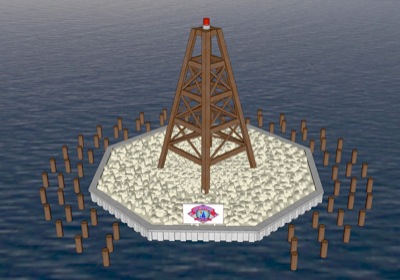Monday, October 8th, 2012
Funds sought for oil derrick replica in lake
By Nancy Allen

Submitted Photo
An architectural drawing shows what the replica of an oil derrick in Grand Lake would look like. The Lake Improvement Association hopes to raise $300,000 for the project.
Money is being sought to build a replica of an oil derrick in the center of Grand Lake.
The nonprofit Lake Improvement Association announced Saturday that the estimated $300,000 project would be constructed at the site of a rock pile that marks the location of one of the last remaining oil derricks in the lake.
"After the state reclaims the rocks around the site, we want to build a 55-foot diameter area and put seawall around it and build a 30-foot tall derrick with a solar light on top," said Dave Meyer, who is chairing the project with Kate Anderson and Bob Sachs. "On the northeast side there will be a 4-foot by 8-foot billboard with a history lesson about oil on the lake with donators' names on it if they so wish."
The first offshore oil well in the world was erected on Grand Lake off Villa Nova in 1891. During the next seven years, hundreds of derricks dotted the lake and the land surrounding it, said local historian and lake resident George Neargarder. Neargarder said the companies were looking for natural gas, not oil. Not until Henry Ford started building cars was there a big need for oil, he said. The Neely Clover Oil Co. drilled the first well on the lake and many others before pulling out of the area once supplies were depleted, Neargarder said.
Meyer said the LIA will seek funding for the project from private individuals, corporations and grants. The money will be held by the St. Marys Civic Foundation and donations will be tax deductible.
Meyer said his committee plans to contact a few oil companies still in existence which have a history on the lake. LIA officials also plan to speak with various local civic groups and organizations to get the word out about the project.
Anderson said the project will give the community something of which to be proud. This is important, she said, due to the lake's ongoing problem with toxic algae and negative press it has generated.
"It will give people a place to go on the lake," Anderson said. "If we have pride in this lake then we can help build support to clean it up."
Meyer said the committee has no deadline by which it needs to raise the money.
"We hope to get it raised by spring or summer and if not, we'll do it in 2014," Meyer said.
For more information, contact Meyer at 419-925-4146 or Anderson at 614-558-3105.
In other business Saturday, Tom Grabow, dredge supervisor at Grand Lake St. Marys State Park, reported it will be a challenge for dredge operators to reach this year's goal of removing 275,000 cubic yards of muck from the lake. Low water levels have made it difficult to float dredges, which are hitting solid hard pan in heavily silted areas and scrap rubber fill from decades ago.
"At Otterbein, we picked up lots of rubber and that fouls up the dredges," Grabow said, adding dredge operators would fill up a 16-foot work boat with rubber in an hour. "It's cut our production way, way down."
Grabow said dredges have removed 222,388 cubic yards of material and the season is winding down. Last year, dredges removed a record 273,000 cubic yards.
The biggest obstacle to sustained dredging is finding dredge material relocation areas. Grabow said the state just finalized an agreement with a landowner for a DMRA on the south side of Harmon's Landing.
The U.S. Army Corps of Engineers recently approved a permit to allow the creation of a 95-acre wetland in the lake near the Prairie Creek treatment train project, Grabow said.
Dredge material from the lake will be used to fill the site off the lake's shore. Decades ago, there were nearly 3,000 acres of natural littoral wetlands in the lake that have been lost to development. Wetlands act as natural kidneys that filter out sediment and phosphorous, the main nutrient feeding the lake's blue-green algae.
An oval berm made mostly of riprap (rocks) will separate the wetland area from the main body of the lake to contain the sediment.
Grabow said the wetland area will be able to hold 770,000 cubic yards of dredge material.
Jared Ebbing, Mercer County Community Development director, who has worked to secure grants for the Prairie Creek project area, said the estimated cost of the project is $1.2 million. The funds to build it will come from the Ohio Department of Natural Resources, Ebbing said.


